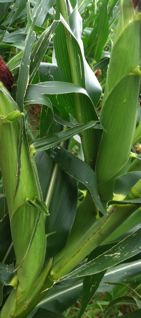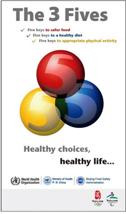 In the Northeast, August is the month where truly more localized produce variety increases and all sorts of marketplaces will start to feature a wider range of locally sourced product.
In the Northeast, August is the month where truly more localized produce variety increases and all sorts of marketplaces will start to feature a wider range of locally sourced product.
We’d like to share some tips below to help make shopping for August Abundance that much more enjoyable for you. We’ll include ideas for before you head out shopping, once you arrive at the market place destination and while you are there, and then after you get back home again.
In PA the weather has often been more temperate in the growing regions and they’ve had enough rain fall to enable farmers to send their harvest to stores that buy directly from them, including ones in NY.
(Photo of corn stalks growing in a farmer’s field courtesy of our webmaster in PA).
As the month progresses, here in the Northeast, we expect to see sweet corn (including the classic “butter and sugar” variety), along with some early apples showing up at farm stands, farmers markets, and in grocery stores that buy “locally” as well. (Usually some produce will come in from both NJ and PA as well as NY).
Do you remember what other fruits and vegetables are typically seasonally available in the Northeast right now?
It’s also time for blueberries, cherries, melons, peaches, pears, plums; as well as beans, beets, broccoli, cabbage, carrots, celery, sweet corn, cucumbers, eggplant, garlic, green beans, lettuce, mushrooms, okra, onions, peppers, potatoes, radishes, spinach, summer squash & zucchini, tomatoes, and possibly turnips. (The Finger Lakes Region often has some of the most luscious peaches and apples in August and may feature them during Harvest Dinner celebrations held at some vineyards as the month progresses). There is a bounty of fresh fruit and vegetable sources to choose from (including some cruciferous ones), rich in anti-oxidants, providing beneficial anti-inflammatory action in the body know to be helpful in not only cancer prevention but also in promoting heart health and all organ health. Fruits and vegetables are a mainstay of the Mediterranean Diet rich in real food flavor as well as so many desirable nutrients.
Usually starting in July and continuing through August and September, some WIC programs will even feature special Farmer Market Days enabling WIC food voucher coupons to be used to purchase healthier choices at local Farmers Markets held in urban areas. In September going into October, cauliflower and some other fall theme vegetables will also typically be available including butternut squash, spaghetti squash, pumpkins other winter squashes, fingerling potatoes and sweet potatoes, etc.
In NYS, there is the Just Say Yes to Fruits and Vegetables program which has its own website. Just Say Yes to Fruits and Veggies (JSY) is a USDA Supplemental Nutrition Education Program (SNAPed).
JSY notes on their website that the program “empowers folks who utilize food stamps or emergency feeding sites to make healthier choices by teaching them simple and affordable ways to increase their fruit and vegetable intake. The program receives statewide federal funding through USDA’s Supplemental Nutrition Assistance Program Nutrition Education (SNAP-Ed) project, with local cost share funds from the New York State Department of Health (NYSDOH), Hunger Prevention Nutrition Assistance Program (HPNAP). SNAP-Ed is a federal/state partnership that supports nutrition education for persons eligible for the Supplemental Nutrition Assistance Program (SNAP).”
Anyone can access the menu and recipe ideas on the JSY site, so feel free to check out their seasonal suggestions.
Before heading off to claim some of Nature’s Bounty for your own table this month, here are a few pointers to keep in mind as you plan to check out in person varied venue shopping opportunities.
The following are being mentioned for infotainment purposes only in a spirit of recognizing your right of choice as a consumer. We leave the discretion of what you do or do not buy up to your ability to make an informed decision.
 1. If you haven’t already, be sure to download and double-check the Environmental Working Group’s (EWG) 2012 Shoppers Guide to Pesticides in Produce™ released June 19, 2012, based on a list total of 45 combined fruits and vegetables.
1. If you haven’t already, be sure to download and double-check the Environmental Working Group’s (EWG) 2012 Shoppers Guide to Pesticides in Produce™ released June 19, 2012, based on a list total of 45 combined fruits and vegetables.
About a decade ago, the Environmental Working Group (EWG) started to compile their own index of pesticide residues in produce based on USDA data on pesticide residues. The now famous EWG Shoppers Guide was developed after EWG staff started to review the data and now staff review this USDA data every year.
(Image of EWG.ORG property of the Environmental Working Group and shown here only for identification purposes).
EWG compiles their own annual summary of the produce items with the greatest concentration of pesticide residues (aka the worst) called the Dirty Dozen™ and also now compiles a listing of the ones with the least pesticide residues found in them (aka the best) called the Clean 15™. You can even catch some video clips on their website to better understand their viewpoint in releasing this listing every year now.
If you follow the suggestions of the Clean 15™ for buying your produce, you may reduce your intake of pesticide residue intake on your fresh food items exposure by as much as 80% each and every day. When it comes to the Dirty Dozen™ listing, consider PEELING the item or otherwise discarding the outer layer where most of the pesticide residue can be found.
The choice of what you buy is totally up to you. It’s not unreasonable to consider buying non-organic choices such as corn, since one would be removing the corn husks anyway, or melons since one would be removing melon rinds anyway, etc. On the other hand, if you plan to buy apples, we all know the fiber in apple skins is beneficial, thus it makes good sense to buy organic choices when it comes to apples so that you can leave the skin on if desired.
 2. No matter where you stand on the Genetically Modified Organisms (GMOs) controversy, stay informed about the options when it comes to Genetically Engineered (GE) food choices.
2. No matter where you stand on the Genetically Modified Organisms (GMOs) controversy, stay informed about the options when it comes to Genetically Engineered (GE) food choices.
If you prefer to shop for non-genetically modified organism (non-GMO) choices, then some information available from the Institute for Responsible Technology may be of interest to you. There is a Non-GMO Shopping Tips piece they put out which you can read for more information when it comes to awareness of items in the marketplace, especially if you wish to avoid GE food items potentially made with GMOs. They also put out a Non-GMO Shopping Guide should you be interested in that.
(Image of non-GMO shopping guide property of the Institute for Responsible Technology and shown here only for identification purposes).
 3. Since it is Olympic season, utilize “take home” message information from the time of the 2008 Beijing Olympics –it is just as valid now as it was then.
3. Since it is Olympic season, utilize “take home” message information from the time of the 2008 Beijing Olympics –it is just as valid now as it was then.
The 3 Fives was released by the World Health Organization (WHO) and identifies the Five Keys to Safer Food, Five Keys to a Healthy Diet, Five Keys to Appropriate Physical Activity.
(The 3 Fives image is property of the WHO and only shown here for identification purposes).
We’ve addressed food safety in some other blog posts, so won’t rehash the subject in this one.
4. Remember the “KISS” principle when it comes to food shopping in market place locations that are part outdoor and/or part indoor–Keep It Simple & Safe!
BEFORE GOING SHOPPING:
- Dress for Outdoor Shopping Success–wear comfortable, loose fitting, light colored clothing to stay cooler; choose footwear you can easily walk and stand in; and don’t forget a protective brimmed hat with airflow; it is OK to bring a storage device on wheels to help you cart around your shopping finds (makes it easier on your back and shoulders and arms!)
- Scout out any online layouts of a location first as often there are diagrams of locations, where there is shelter, bathrooms, etc. and that information can be beneficial. Plan out your route within the market place if at all possible so that the most perishable items are checked out last just before heading home.
- Although you should come with a desired list of what you seek, be willing to deviate from it a little if some good finds should appear that are irresistible!
- Often the selection is best earlier in the market hours vs later in the market hours; also the items will be freshest and often at more optimal temperatures earlier in the market hours; if you have the time, take a “once around” to scope out the options before you do any serious buying
- Some vendors do take advance orders so if you frequent a specific farmers market, find out if any of the farmers booths that you like to frequent happen to do that; some may offer discounts if you can use mixed sizes of items, or produce that has a short shelf life and is ready to be used right away and won’t keep (so long as you can really deal with that time urgency factor and not let the food go to waste).
- Carry enough “exact change” as in smaller bills and even some loose change as it makes it easier for vendors and may at times help you strike a better deal as shopping is winding down as often vendors might run out of smaller bills and change toward the end of market hours. It is handy to store money in a waist pack.
- Bring water bottles for yourself (and any companions) with you (we find smaller refillable ones that you can add both water and crushed ice to work best as the crushed ice melts keeping the water cooler)
UPON ARRIVAL AT THE MARKET PLACE & WHILE SHOPPING:
- Park in shade if you can (a good reason to go early!)
- Use blue ice packs in a cooler in the car if possible to help keep perishable items cold on the trip home–and bring perishable items back to that cooler often during your outdoor shopping excursion; bring more than one cooler if at all possible; bring something to snack on to refresh yourself & others as needed;
- Use separate shopping bags for items that could cross-contaminate
- Ask before trying anything in case there might be unexpected ingredients used in any recipe you might taste while out and about
- Bring & use your own disposable toothpicks or tasting picnic tableware if you plan to taste items at outdoor locations, and don’t forget extra napkins and paper towels, too
- Use disposable hand wipes/sanitizing gel on your hands after touching food items or containers where cross-contamination is more likely to happen
- Don’t overbuy as wasting food is never a bargain
WHEN YOU GET HOME:
- Check over your finds and remove anything that is damaged and requires immediate processing
- Refrigerate any perishables promptly continuing to prevent cross-contamination
- Remember NOT to wash too far ahead of time those fruits that are best washed only just before serving
- Always appropriately clean/sanitize shopping bags as needed after use and store blue ice back in the freezer
- Prepare up as applicable the wonderful produce you were able to acquire on this shopping trip and definitely savor the flavor of nature’s bounty…sharing that experience as feasible with family and friends

